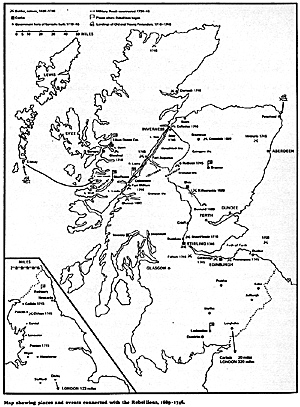The term Jacobite derives from the Latin word "Jacobus" meaning James and was applied to the political followers of the exiled Stuart kings of England during the late Seventeenth through Eighteenth Centuries. The Catholic king James II of England and VII of Scotland was driven into exile following the successful invasion of England in 1688 by his son-in-law, the Protestant William of Orange. William and his wife Mary, the daughter of James II, had been invited by Anglican clergy and Whig politicians in Parliament to invade the country and seize power from James.
When James fled the country for France, Parliament gave the royal crown to William and Mary. Mary's sister Anne became Queen of England following William's death in l702. Queen Anne died without direct heir in 1714 and was succeeded by the Protestant Elector of Hanover, George I, a great-grandson of James I. This "Hanoverian Succession" would ultimately provide the fuel for a number of Jacobite rebellions.
Between 1689 and 1745, there were no less than five attempts to restore the Stuart dynasty. The most serious of these would the rising instigated by Prince Charles Edward Stuart, the grandson of James II, in 1745. Known simply as the "Forty-Five", it ranks as one of history's most celebrated lost causes and continues to stir the emotions to this day. Its hero, the dashing "Bonnie Prince Charlie" is much written about in song and tale and contrasts greatly with the image of its villian, the fat and brutal Duke of Cumberland. The defeat of Bonnie Prince Charlie and his followers at Culloden on April 16, 1746 signaled an end to Jacobitism as a force capable of disrupting British political life in the Eighteenth Century.
Origins
The origins of the Forty-Five had their seed in the restoration of the English monarchy under Charles II in 1660. Seventeenth and Eighteenth Century England held a deep-seated intolerance for Catholicism and anything that smacked of "popery". Charles, like the previous Stuart kings, James I and Charles I, was a Protestant and had he not died without a legitimate male heir, there never would have been a Forty-Five. Charles' brother James, on the other hand, had converted to Catholicism following the Restoration and he was much reviled by the liberal Whig Party in Parliament on account of his religion and his absolutist political outlook.
James compounded his unpopularity by marrying the Catholic princess, Mary of Modena, following the death of his first wife, Anne Hyde. James had sired two daughters through his first marriage, the future queens Mary and Anne, who were raised as Protestants. James' second marriage prompted the Whigs, who were alarmed at the prospect of James becoming king and producing a Catholic heir by his second marriage, to promote an Exclusion Bill that would preclude James and his heirs from assuming the crown after Charles II. Gradually public sentiment towards James changed along with the growing power of the conservative Tories in Parliament. When Charles II died in 1685, James Stuart was crowned James II of England and VII of Scotland without incident.
In June of 1688, his wife Mary gave birth to a son, christened James Francis Edward Stuart, and this event set the forces of revolt into motion. As long as James lacked a male heir, his opponents could tolerate him, for it was presumed that he would one day be succeeded by his Protestant daughter Mary, and her husband, Prince William of Orange (Holland).
The birth of the baby James ruled out a Protestant succession and in November 1688, Anglican clergy and Whig politicians invited William of Orange to invade England with a Dutch army and remove James II from power. William gladly complied and landed his army at Torbay, in southwest England. His march towards London was virtually unopposed, and this lack of response on the part of James led to the wholesale desertion of the King's army to William's side. James fled London on Christmas Eve and allegedly tossed the Great Seal of England into the Thames River, an act interpreted by Parliament as a formal abdication of the throne. William III and Mary II were crowned as joint sovereigns on April 11, 1689.
James II was given sanctuary in France by Louis XIV and was allowed to set up a court-in-exile at the Palace of Sainte Germaine. Almost immediately, followers began to coalesce about the court and plans were made to return to England.
Map showing various places of rebellion 1689-1746

More Origins of the Jacobite Rebellion 1745
- Introduction
Dundee's Rising In 1689
The Old Pretender
The Great Rising of 1715
The Little Rising of 1719
The "Forty Five" (1745)
Back to Seven Years War Asso. Journal Vol. VI No. 4 Table of Contents
Back to Seven Years War Asso. Journal List of Issues
Back to Master Magazine List
© Copyright 1993 by James E. Purky
This article appears in MagWeb (Magazine Web) on the Internet World Wide Web.
Other military history articles and gaming articles are available at http://www.magweb.com